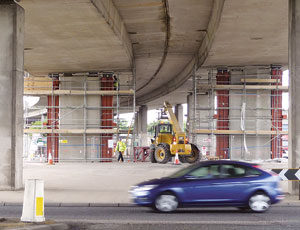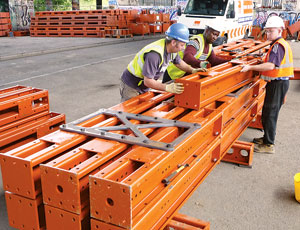The normal clutter of braced shoring is absent on a U.K. job to replace viaduct bearings near London because the shoring firm has created a cheaper and simpler megaprop system by bolting together standard stock. “We’ve never made these composite props before,” says Ian Fryer, engineering director for supplier RMD Kwikform Ltd., Walsall. “We hadn’t thought of it.”


Replacing the 108 bearings is part of a $9.2-million project to refurbish Country Way A316 viaduct. Prime contractor Carillion plc., Wolverhampton, started last May and is due to finish this spring.
To raise the deck progressively off existing bearings, subcontractor Freyssinet Ltd., Telford, needed a versatile propping system to deal with varying pier heights and configurations. The system also had to support vertical loads approaching 900 tonnes and handle large side loads.
RMD usually would have offered braced towers with hefty header beams, says Fryer. Instead, the company assembles megaprops on-site in modules of three lengths up to 5.4 m for pier heights ranging from 2.5 m to 9 m.
RMD bolts nine of its roughly 30-by-30-cm section standard Megashor props in three columns of three. The megaprops are stiffened in one direction with steel plates bolted 1.2 m apart in spaces left be-tween sets of three props. In the other direction, the megaprops brace each other in different ways.
Where pairs of piers support the viaduct, they are so wide they need two megaprops each placed against opposing outer edges and stressed together with tie bars. Where there are four or six piers, each has one megaprop; they are strutted apart to press against the piers’ inner faces. RMD deploys megaprops at two rows of piers while installing or removing them at another two.
To restrain megaprops from moving sideways, Fryer came up with a novel arrangement: The 30-cm-deep fabricated header on each megaprop has vertical serrations on the pier side. The serrated face is oiled and grouted to roughened pier concrete. It can move up and down under changing loads, but not sideways.
“We got a good cycle,” says Freyssinet operations manager Ian Campbell “It’s a very repetitive system.” he says.


Post a comment to this article
Report Abusive Comment